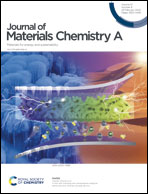Enhanced electromechanical properties in low-temperature gadolinium-doped ceria composites with low-dimensional carbon allotropes
Abstract
We couple the spark plasma sintering (SPS) technique with the ball mill process to fabricate a new electro-chemo-mechanical functional carbon–metal oxide hybrid material. Graphene oxide (GO) or carbon nanotubes (CNT) carbon allotropes are mechanically mixed with gadolinium-doped ceria (CGO). SPS allows consolidating dense carbon–metal oxide hybrids with uniform morphology and high crystallinity. The carbon allotropes and SPS lead to highly reduced CGO. The metal oxide presents a chemically tuned grain boundary with highly oxygen defect concentration at the near-grain boundary region. The hybrid interface can hinder chemical oxidation at high-temperature depending on the carbon allotropy. As a result, the hybrid materials with CNT display high ionic conductivity and activation energy, reducing the space charge layer and charge distribution. This feature enhances the electromechanical properties at room temperature. We especially disclose electrostriction in the CNT-based hybrids superior to the pure CGO and follow a non-Newnham relation. Notably, integrating carbon materials with metal oxides using the SPS can generally be applied to synthesising a range of functional metal oxide composite.



 Please wait while we load your content...
Please wait while we load your content...